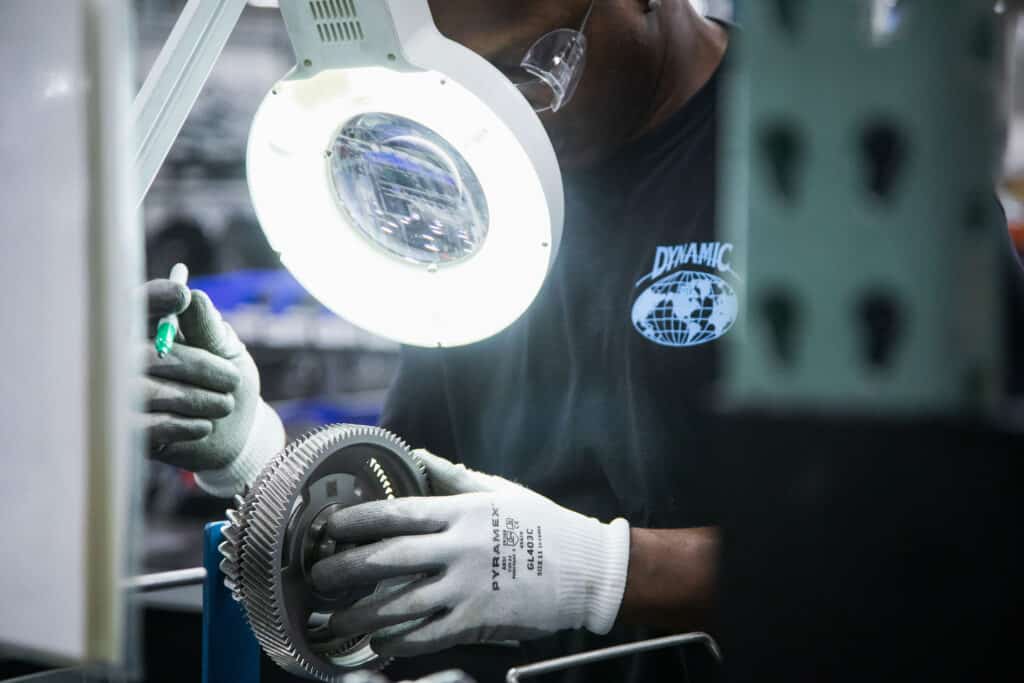
Article At A Glance
- The ICE drivetrain components are crucial for a vehicle’s performance, and remanufacturing helps maintain their reliability and durability.
- Remanufacturing is cost-effective for OEMs, allowing them to invest in electrification strategies and offer lower-priced options to customers.
- Advanced remanufacturing techniques enhance the durability of drivetrain parts, making them comparable to or even better than new parts.
As the automotive industry evolves rapidly, remanufacturing has become an attractive option for OEMs to extend product lifespans and achieve sustainability goals. Through the remanufacturing process, critical Internal Combustion Engine (ICE) drivetrain components, such as transmissions and differentials, can maintain high performance and durability for an extended time. This creates benefits that range from cost savings to a reduced environmental footprint.
What is Remanufacturing, and Why OEMs Are Embracing It
Remanufacturing is the practice of restoring used or worn parts to a “like-new” condition, typically meeting or even exceeding the original standards. In the automotive remanufacturing sector, this means dismantling, refurbishing, and testing drivetrain components to ensure they perform reliably. OEMs increasingly turn to remanufacturing because it improves environmental performance by reusing resources and reducing waste.
This proactive approach contributes to sustainable development within the remanufacturing industry. It also helps OEMs maintain a competitive edge in a market that increasingly values environmental responsibility. Incorporating remanufactured parts into product lines enables OEMs to cater to a growing consumer base that values sustainability.
Additional Read: The Value of Remanufactured Transmissions: Quality and Cost Benefits for OEMs
Understanding the Importance of ICE Drivetrain Components
The ICE drivetrain, composed of key components such as the transmission, differential, and axles, is crucial to a vehicle’s performance. These systems transfer power from the engine to the wheels, affecting everything from efficiency to driving comfort. For OEMs, maintaining the durability of these drivetrain systems is essential for supporting both internal combustion engine vehicles and electric vehicles.
Remanufacturing keeps these systems reliable, reducing the need for entirely new drivetrain products. This helps OEMs meet consumer expectations while reinforcing brand reputation. High-quality remanufactured components undergo rigorous quality control processes, ensuring they match or exceed the specifications of new parts.
Cost Savings for OEMs Through Remanufacturing ICE Drivetrain Parts
One of the significant benefits of remanufacturing is the potential for cost savings. Creating new parts requires substantial amounts of materials, energy, and labor. However, restoring a component can be more cost-effective while still meeting high-performance standards.
This efficiency allows OEMs to reinvest savings into electrification strategies and electric vehicle solutions. Remanufacturing enhances the life cycle assessment of these products, offering high-quality, remanufactured items at a lower price point. This makes remanufacturing an attractive option in a competitive automotive market.
The financial advantages extend beyond direct savings. By opting for remanufactured components, OEMs can mitigate risks associated with fluctuating raw material prices and supply chain disruptions. This added financial stability allows manufacturers to plan more effectively for the future.
Additional Read: The Importance of Remanufacturing in the Automotive Industry: Enhancing Longevity, Sustainability, and Cost Efficiency
Improving Drivetrain Durability Through Remanufacturing Processes
Remanufacturing not only restores but also enhances the durability of the drivetrain. Advanced techniques, including re-machining and specialized coatings, can make drivetrain parts like transmissions and differentials more resilient. The remanufacturing process involves disassembling, inspecting each core component, refurbishing or replacing defective components, and rigorously testing each part.
These steps extend each component’s service life, improve performance, and create a product that meets or even surpasses the quality of new parts. Quality assurance is crucial in the remanufacturing process. Each step, from disassembly to reassembly, is closely monitored to ensure compliance with OEM specifications.
Sustainability Benefits for OEMs Leveraging Remanufacturing
As sustainability takes center stage, remanufacturing aligns perfectly with OEMs’ environmental assessment strategies. The approach supports a circular economy by reducing natural resource consumption and waste. This results in lower energy demand and fewer emissions, contributing to pollution reduction efforts.
Customers are increasingly conscious of environmental practices. Remanufacturing satisfies this demand while supporting carbon footprint reduction. The environmental benefits of remanufacturing are particularly important in a world where sustainability is paramount.
Reducing reliance on virgin materials allows OEMs to minimize their overall environmental impact. This shift resonates with environmentally-conscious consumers and aligns with regulatory efforts to promote sustainable manufacturing. Remanufacturing contributes to a more sustainable future for the automotive industry.
Core Drivetrain Components Frequently Remanufactured
Commonly, remanufactured parts include high-value drivetrain elements like transmissions, differentials, and axles. These components are subject to heavy wear and tear, making them ideal for remanufacturing. For example, remanufactured transmissions provide the same reliability as new units but are cheaper.
This makes remanufacturing an attractive option for customers seeking reliable alternatives. Remanufacturing enables OEMs to support warranties, enhancing the competitive advantages that foster customer loyalty. As the automotive landscape shifts towards electrification, remanufactured ICE components remain relevant.
Many consumers will continue to rely on ICE vehicles for the foreseeable future. This makes remanufactured components a vital part of the industry’s transitional phase. OEMs can effectively bridge the gap between traditional and electric vehicle technologies by providing high-quality, remanufactured options.
Quality Control in the Remanufacturing Process
Maintaining quality standards is crucial in remanufacturing, especially for complex drivetrain systems. Rigorous testing and diagnostic tools are used throughout the remanufacturing process to ensure the performance and durability of remanufactured products. Each stage of testing and inspection ensures compliance with OEM standards.
A robust quality control process is essential in an era where consumers prioritize quality and reliability. The remanufacturing industry has developed best practices focused on precision engineering. This ensures that every remanufactured part functions seamlessly within the larger system.
This commitment to quality protects the OEM’s reputation and enhances the reliability of the vehicles that utilize these components. As the automotive market continues to grow and evolve, maintaining high standards in remanufacturing will be vital for meeting consumer demands.
Remanufacturing’s Role in the Shift Toward Hybrid and Electric Vehicles
As vehicle electrification gains momentum, remanufacturing remains essential for extending the life of existing ICE components. Many OEMs are balancing traditional ICE products with new electric vehicle systems. This ensures they meet diverse customer needs while transitioning to battery electric solutions and hybrid technologies.
Remanufacturing ICE drivetrain parts allows OEMs to maintain reliable options during this transition. This dual approach helps them cater to various customer needs while adopting circular economy strategies to promote sustainability. As the market for electric vehicles expands, the demand for remanufactured ICE components is likely to increase.
Consumers may seek reliable alternatives to traditional vehicles while considering future electric options. Investing in remanufacturing practices allows OEMs to meet the growing demand effectively. Remanufacturing can help OEMs address the challenges posed by the changing landscape of the automotive industry.
Conclusion: Embracing Remanufacturing for a Sustainable Future
As the automotive industry continues to evolve, remanufacturing presents a practical approach for extending the life of ICE drivetrain components. This process reduces costs and helps achieve sustainability goals while supporting environmental commitments and customer expectations.
Investing in remanufactured parts allows OEMs to enhance their product offerings and remain competitive in a rapidly changing market. For more information on the benefits of remanufacturing or to discuss customized solutions, contact Dynamic Manufacturing in Hillside, IL, at (708) 343-8753.



